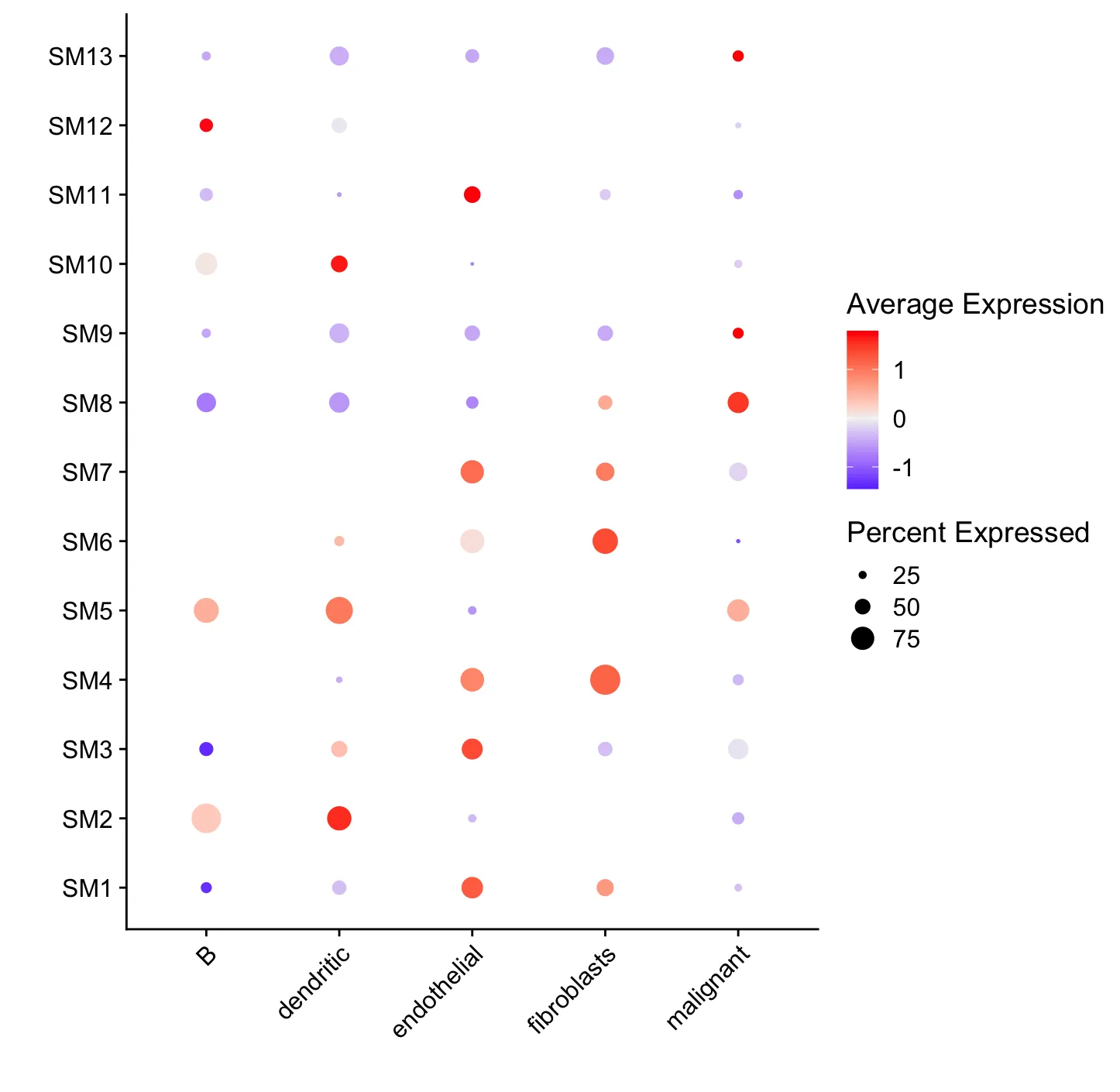基于Seurat的空转单样本数据分析流程学习(四)-hdWGCNA
原创基于Seurat的空转单样本数据分析流程学习(四)-hdWGCNA
原创
凑齐六个字吧
发布于 2025-09-21 12:51:29
发布于 2025-09-21 12:51:29
hdWGCNA全称是high-dimensional Weighted Gene Co-expression Network Analysis,即高维加权基因共表达网络分析。它是对经典的WGCNA(Weighted Gene Co-expression Network Analysis)方法的扩展和优化,专门适配单细胞转录组(scRNA-seq)和空间转录组(ST)数据。
分析流程
1.导入
rm(list = ls())
library(Seurat)
library(tidyverse)
library(cowplot)
library(patchwork)
library(WGCNA)
library(hdWGCNA)
enableWGCNAThreads(nThreads = 8)
dir.create("0-hdWGCNA")
setwd("0-hdWGCNA") 2.数据预处理
hdWGCNA要求空间坐标存储在meta.data中,因此单样本读取的方式可能更加合适,使用了GSM8633891和GSM8633892这两个样本
getwd()
data <- Read10X_h5("./GSE281978/GSM8633891/filtered_feature_bc_matrix.h5")
dim(data)
object <- CreateSeuratObject(counts = data,
assay = "Spatial",
min.cells = 3, #过滤在少于3个细胞中表达的基因,以减少低表达基因的干扰
project = "GSM8633891")
object
# 再读取
image <- Read10X_Image(image.dir = "./GSE281978/GSM8633891/spatial/",
image.name = "tissue_hires_image.png",
filter.matrix = TRUE)
image
dim(image)
image <- image[Cells(x = object)]# 筛选图像对象中包含的SPOT
DefaultAssay(object = image) <- "Spatial" # 设置图像对象的默认assay为"Spatial"
# 添加图片到object中
object[["GSM8633891"]] <- image
object@images[["GSM8633891"]]@scale.factors$lowres <- object@images[["GSM8633891"]]@scale.factors$hires
# scale.factors
object@images[["GSM8633891"]]@scale.factors
seurat_obj <- object
## 简单探索一下数据结构
as.data.frame(seurat_obj[["Spatial"]]$counts[1:4,1:4])
as.data.frame(LayerData(seurat_obj,
assay = "Spatial",
layer = "counts")[1:5,1:5])
head(seurat_obj@meta.data)
table(seurat_obj$orig.ident)
Layers(seurat_obj)
Assays(seurat_obj)
# 添加坐标信息
# 增加barcode列信息给Seurat obj
seurat_obj$barcode <- colnames(seurat_obj)
# 读取样本路径
tissue_positions <- read.csv('./GSE281978/GSM8633891/tissue_positions_list.csv',header = T)
tissue_positions <- subset(tissue_positions, barcode %in% seurat_obj$barcode)
# 将image_df与Seurat的元数据合并
new_meta <- dplyr::left_join(seurat_obj@meta.data, tissue_positions, by='barcode')
# 将新的元数据添加到Seurat对象seurat_vhd
seurat_obj$row <- new_meta$array_row
seurat_obj$imagerow <- new_meta$pxl_row_in_fullres
seurat_obj$col <- new_meta$array_col
seurat_obj$imagecol <- new_meta$pxl_col_in_fullres
library(qs)
qsave(seurat_obj, file="./GSE281978/GSM8633891/GSM8633891.qs")数据结构和命名,这里面不同层级中有两个position的表格,更高层级的表格中补充了列名方便添加。

3.数据整合
# load the samples
dat1 <- qread("./GSE281978/GSM8633891/GSM8633891.qs")
dat1$region <- 'GSM8633891'
dat2 <- qread("./GSE281978/GSM8633892/GSM8633892.qs")
dat2$region <- 'GSM8633892'
# merge
seurat_obj <- merge(dat1, dat2)
seurat_obj$region <- factor(as.character(seurat_obj$region),
levels=c('GSM8633891', 'GSM8633892'))
#joinlayers
seurat_obj <- JoinLayers(seurat_obj)
qsave(seurat_obj,file = "seurat_obj.qs")4.聚类分析
# normalization, feature selection, scaling, and PCA
seurat_obj <- seurat_obj %>%
NormalizeData() %>%
FindVariableFeatures() %>%
ScaleData() %>%
RunPCA()
# Louvain clustering and umap
seurat_obj <- FindNeighbors(seurat_obj, dims = 1:30)
seurat_obj <- FindClusters(seurat_obj,verbose = TRUE)
seurat_obj <- RunUMAP(seurat_obj, dims = 1:30)
# 设定样本分组
seurat_obj$region <- factor(as.character(seurat_obj$orig.ident),
levels=c('GSM8633891', 'GSM8633892'))
# show the UMAP
p1 <- DimPlot(seurat_obj,
label=TRUE,
reduction = "umap",
group.by = "seurat_clusters") + NoLegend()
p1
p2 <- SpatialDimPlot(seurat_obj,
label = TRUE,
label.size = 3)
p2聚类分析和映射


5.cluster注释
这里的注释是不正确的,仅供演示
# 把准备好的注释添加到Seurat对象中
annotations <- read.csv('annotations.csv',sep = ",")
head(annotations)
# seurat_clusters annotation
# 1 0 fibroblasts
# 2 1 fibroblasts
# 3 2 endothelial
# 4 3 malignant
# 5 4 dendritic
# 6 5 malignant
ix <- match(seurat_obj$seurat_clusters, annotations$seurat_clusters)
seurat_obj$annotation <- annotations$annotation[ix]
a <- seurat_obj@meta.data
colnames(seurat_obj@meta.data)
# 设定注释
Idents(seurat_obj) <- seurat_obj$annotation
p3 <- SpatialDimPlot(seurat_obj, label = TRUE, label.size = 3)
p3 + NoLegend()
6.构建metaSpots
Visium空间转录组(ST)在每个spot中生成的是稀疏的基因表达谱,因此在共表达网络分析中存在与单细胞数据相同的潜在问题。为了缓解这些问题,hdWGCNA提供了一种数据聚合方法,用于生成空间metaspots,类似于之前的metacell算法。这种方法是根据空间坐标(而非转录组表达)聚合相邻的 spot。在hdWGCNA中,这一过程可以通过 MetaspotsByGroups 函数来实现。

在这里,为 hdWGCNA 设置数据并运行 MetaspotsByGroups。类似于MetacellsByGroups,group.by 参数用于对Seurat 对象seurat_vhd 进行分组,从而为每个组单独构建 metaspots。这里仅按ST切片(slides)进行分组,以便分别对不同样本执行此步骤,也可以根据分析需要指定cluster或解剖区域(anatomical regions)来进行分组。
seurat_obj <- SetupForWGCNA(
seurat_obj,
gene_select = "fraction",
fraction = 0.05,
wgcna_name = "vis"
)
seurat_obj <- MetaspotsByGroups(
seurat_obj,
group.by = c("region"),
ident.group = "region",
assay = 'Spatial'
)
seurat_obj <- NormalizeMetacells(seurat_obj)7.共表达网络分析
7.1 软阈值分析
# set up the expression matrix, set group.by and group_name to NULL to include all spots
seurat_obj <- SetDatExpr(
seurat_obj,
group.by=NULL,
group_name = NULL
)
# test different soft power thresholds
library(doParallel)
registerDoParallel(1) # 单线程
seurat_obj <- TestSoftPowers(seurat_obj)
plot_list <- PlotSoftPowers(seurat_obj)
wrap_plots(plot_list, ncol=2)
7.2 Spatial hdWGCNA dendrogram
# construct co-expression network:
seurat_obj <- ConstructNetwork(
seurat_obj,
tom_name='test',
overwrite_tom=TRUE
)
# plot the dendrogram
PlotDendrogram(seurat_obj, main='Spatial hdWGCNA dendrogram')
7.3 计算模块特征基因(MEs)和基于特征基因的连通性(kMEs)
seurat_obj <- ModuleEigengenes(seurat_obj)
seurat_obj <- ModuleConnectivity(seurat_obj)7.4 用前缀“SM”(空间模块)重置模块名称
seurat_obj <- ResetModuleNames(
seurat_obj,
new_name = "SM"
)7.5 可视化
# get module eigengenes and gene-module assignment tables
MEs <- GetMEs(seurat_obj)
modules <- GetModules(seurat_obj)
mods <- levels(modules$module); mods <- mods[mods != 'grey']
# add the MEs to the seurat metadata so we can plot it with Seurat functions
seurat_obj@meta.data <- cbind(seurat_obj@meta.data, MEs)
# plot with Seurat's DotPlot function
p <- DotPlot(seurat_obj, features=mods, group.by = 'annotation', dot.min=0.1)
# flip the x/y axes, rotate the axis labels, and change color scheme:
p <- p +
coord_flip() +
RotatedAxis() +
scale_color_gradient2(high='red', mid='grey95', low='blue') +
xlab('') + ylab('')
p
# 图太大了
#p1 <- SpatialFeaturePlot(
# seurat_obj,
# features = mods,
# alpha = c(0.1, 1),
# ncol = 8
#)
#p1
options(future.globals.maxSize = 50 * 1024^3)
# perform UMAP embedding on the co-expression network
seurat_obj <- RunModuleUMAP(
seurat_obj,
n_hubs = 5,
n_neighbors=15,
min_dist=0.3,
spread=1
)
# make the network plot
ModuleUMAPPlot(
seurat_obj,
edge.alpha=0.5,
sample_edges=TRUE,
keep_grey_edges=FALSE,
edge_prop=0.075,
label_hubs=5
)
参考资料:
- hdWGCNA:https://smorabit.github.io/hdWGCNA/articles/ST_basics.html
注:若对内容有疑惑或者有发现明确错误的朋友,请联系后台。更多相关内容可关注公众号:生信方舟 。
原创声明:本文系作者授权腾讯云开发者社区发表,未经许可,不得转载。
如有侵权,请联系 cloudcommunity@tencent.com 删除。
原创声明:本文系作者授权腾讯云开发者社区发表,未经许可,不得转载。
如有侵权,请联系 cloudcommunity@tencent.com 删除。
评论
登录后参与评论
推荐阅读
目录

